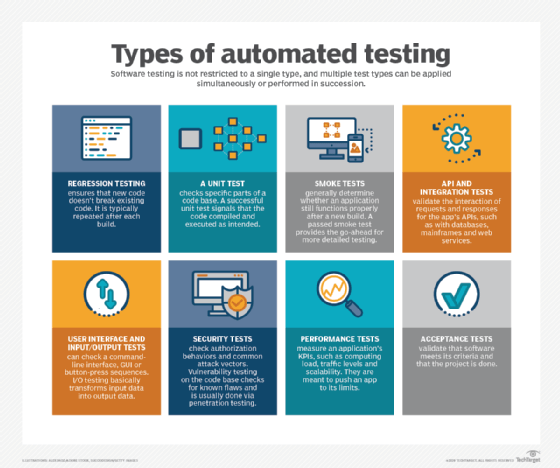Automation Testing: Trick Steps to Simplify Development Lifecycles
Automation Testing: Trick Steps to Simplify Development Lifecycles
Blog Article
From Manual to Automated Testing: A Comprehensive Guide to Transitioning Efficiently and Efficiently
In the world of software screening, the shift from handbook to automated processes has actually become a progressively crucial transition for organizations looking for to improve performance and accuracy in their screening techniques. As technology continues to development, the need for smooth and reliable automatic testing approaches has actually never been much more pressing. The journey from guidebook to automated testing is not without its obstacles, but when come close to strategically and with a clear strategy in mind, the benefits can be significant - automation testing. In this extensive guide, we will certainly discover essential steps and considerations important for an effective transition, from the initial choice of tools to the assimilation of automation into existing process. Keep tuned to uncover the insights that will assist pave the method for a smoother and more efficient testing process.
Benefits of Automated Testing
Automated screening uses countless benefits, enhancing performance and precision in software application development processes. Automated examinations can be run all at once on several tools and operating systems, significantly speeding up the testing phase contrasted to manual testing.
Furthermore, automated testing makes certain a greater level of accuracy in identifying issues. Consistency in testing is also boosted, as automated tests carry out the same actions exactly each time they are run.
Picking the Right Tools

Firstly, examine your objectives and needs. Recognize the extent of your task, the innovations included, and the capability of your group. This analysis will certainly aid you determine the abilities and attributes you require in your testing devices.
Second of all, take into consideration the compatibility of the tools with your existing processes and systems. Smooth integration with your present software application development lifecycle is vital to ensure a smooth change to automation.
Furthermore, evaluate the scalability and versatility of the devices. As your testing requires progress, the devices must have the ability to adjust and fit modifications efficiently.
Lastly, element in the support and neighborhood around the devices. When carrying out automated screening, robust assistance and an active user neighborhood can give useful resources and support. By very carefully thinking about these elements, you can select the right devices that straighten with your requirements and set the phase for an effective change to automated testing.
Writing Efficient Examination Scripts

When crafting examination scripts, it is vital to think about the details requirements of the software program being evaluated and go right here make sure that the manuscripts deal with all critical capabilities. Clear and descriptive naming conventions for test scripts and test instances can enhance readability and maintainability. Furthermore, incorporating mistake handling mechanisms within the examination manuscripts can assist in identifying and attending to issues immediately.
In addition, organizing examination manuscripts right into modular parts can improve reusability and scalability, decreasing redundancy and enhancing effectiveness in test manuscript maintenance. Normal evaluations and updates to test scripts are crucial to equal advancing software demands and functionalities. By complying with these principles, testers can produce efficient and robust test manuscripts that contribute substantially to the success of automated testing procedures.
Integrating Automation Into Workflows
By flawlessly incorporating automated testing tools like Selenium or Appium into the software application growth lifecycle, groups can achieve faster feedback on code adjustments, leading to quicker bug discovery and resolution. This integration allows for constant testing throughout the growth procedure, ensuring that any concerns are recognized early on, resulting in higher software program top quality. Appropriate assimilation of automation tools needs cooperation in between advancement, screening, and operations groups to establish a unified operations that maximizes efficiency and effectiveness in providing top quality software program products.
Ensuring a Smooth Shift
Successfully transitioning to automated testing includes meticulous planning and cautious implementation to reduce disruptions and maximize effectiveness in the software development process - automation testing. To make sure a smooth shift, it is vital to start by conducting a complete analysis of the current testing procedures and determining locations where automation can bring one of the most substantial benefits. Involving with all stakeholders early on while doing so, including designers, testers, and task managers, is vital for gathering support and buy-in for the automation effort
Interaction more info here is vital throughout this change phase. Clear communication of the objectives, benefits, and expectations of automated screening assists to take care of any type of resistance or issues that may arise. Additionally, giving appropriate training and resources for employee to upskill in automation tools and techniques is essential for guaranteeing a successful shift.

Verdict
Finally, transitioning from manual to automated screening provides many advantages, including enhanced efficiency and reliability. By choosing the proper tools, writing effective examination manuscripts, and integrating automation effortlessly right into process, companies can guarantee a smooth and effective shift. It is important to embrace automation as an important asset in software application testing procedures to enhance overall high quality and productivity.
In the world of software application testing, the change from manual to automated processes has become a significantly vital transition for companies seeking to boost performance and accuracy in their screening techniques. Automated examinations site link can be run simultaneously on several tools and operating systems, substantially speeding up the screening phase contrasted to hands-on testing. Consistency in screening is likewise boosted, as automated examinations carry out the same actions exactly each time they are run.To guarantee the successful application of chosen screening tools, the creation of effective test scripts plays an essential function in validating the functionality and efficiency of automated procedures - automation testing. By following these principles, testers can produce effective and durable examination manuscripts that contribute significantly to the success of automated testing processes
Report this page